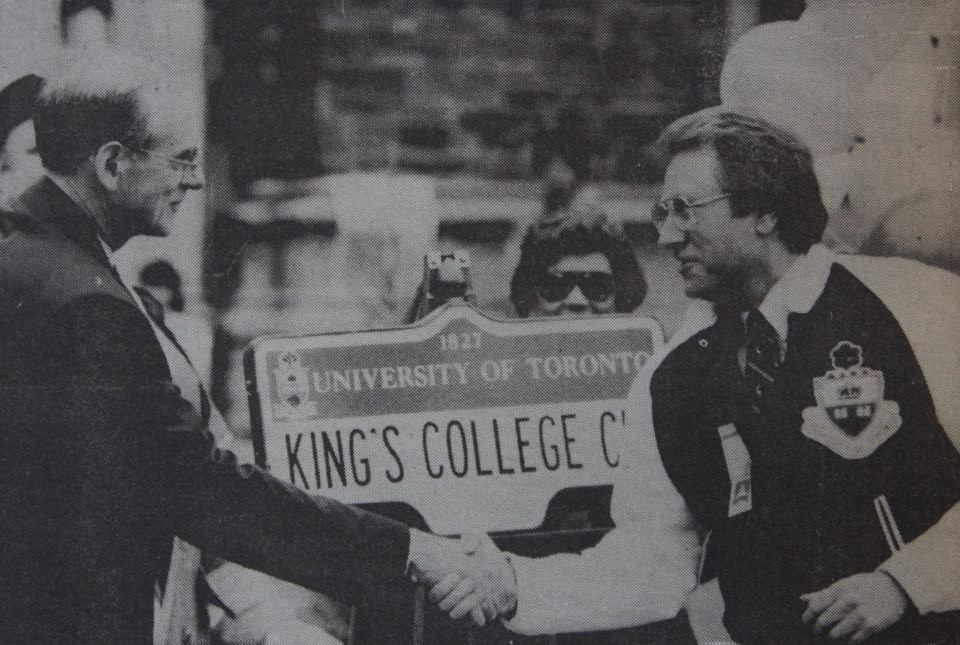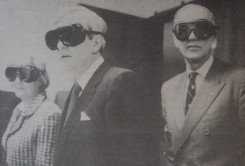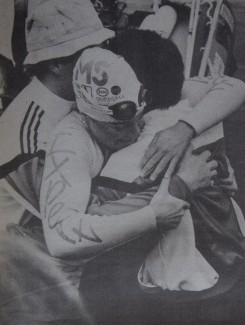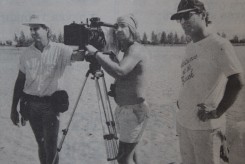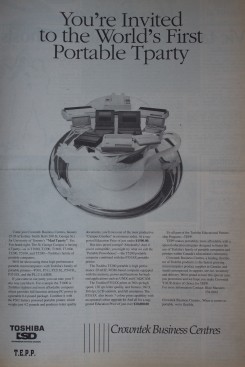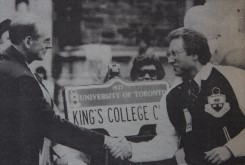Teodora Pasca, second-year, criminology and ethics, society & law, Varsity Associate Comment Editor:
In 30 years, no student will feel unwelcome because of where they were born. Students who are religious will feel safe voicing their opinions and practicing their beliefs on campus. First Nations students will no longer be the first in their families to attend post-secondary, and will have their voices heard in student associations as well as within the classroom.
In 30 years, female students will no longer have to worry about being accosted on their way home from evening classes. Male students will be able to join culinary clubs and attend dance classes without their sexuality being questioned. Students who do not identify within the gender binary will no longer need to go out of their way to find washrooms that they can use with dignity and without scrutiny.
In 30 years, students will set their superficial differences aside in favour of treating one another with respect. Students of all genders and backgrounds will be able to find services and resources tailored to their specific needs. No student will feel excluded, ostracized, or degraded; instead, everyone will be welcome within the university environment.
We are now in 2015, and we’ve come a long way in the name of equity; in fact, there are hundreds of campus policies and resources that are dedicated to this very cause. Yet, the University of Toronto is far from completely equitable, fair, or inclusive, and there are students who still face problems of this kind across campus. This is why we can’t give up yet. The hope is that if we continue to progress, in 30 years, these problems will be solved for good.
Emmeline Molnar, Fourth-year, environmental studies and English literature:
On the whole, I expect the university to experience a shift in values in 30 years. Whether that shift will mean that EDM music shifts into the classics genre in a students’ iPod-of-the-future or not, I do not know. However, I can predict a shift that will likely highlight the university’s increasingly cultivated environment. Technology’s mass expansion into online learning has already begun challenging the supremacy of in-class education. Ever-increasing opportunities for online degrees might displace future students’ participation in a traditional university environment.
Direct interaction with academic material, reputation building, and collaborative learning has been sought-after in the university for hundreds of years. How will these factors change in the face of increasing enrollment and the expansion of the university as an institution?
In 30 years, the physical campuses of U of T could be faced with the task of advocating for the value of a non-virtual university experience. This may extend into athletics, lab classes, field research, and living with fellow students in residence.
We might even see a new hierarchy emerge in our education system, with a practical university experience exclusively positioned at the top, and online degrees becoming the new status quo.
All predispositions to pessimism aside, I figure a shift in values will trend towards the reevaluation of several seemingly irreplaceable components of life. And although technology can connect people, its environment is virtual. It is not hard to imagine that traditional universities in 2045 will be exclusive enclaves of shared experience and community.
In the coming world of ‘virtual’ and ‘non-virtual,’ universities will provide physical and virtual environments. And while there is value in having exposure to both forms of reality, especially in balance with one another, the time will come for students to make a choice.
Staring wide-eyed into an omniscient screen or wherever you go, or venturing through a tree-lined learning hub? This is no trick question.
John Kruspe, Senior Lecturer at the Faculty of Music:
New Year’s celebrations tonight! We’re ushering in 2045, the centenary of the end of the Second World War and the only use of nuclear weapons on human beings.
Here at the University of Ontario (Toronto campus) one of the most significant – and least visible – changes that you, visitor from 2015, will encounter, is what back in the late twentieth century was lovingly nicknamed ‘Fort Book’ – the John P. Robarts Library. All previously circulating volumes in what was then the university’s largest library have long been transferred to Downsview Library. What was formerly the thirteenth floor, is now the renowned Marshall McLuhan Rare Book museum, a tourist mecca attracting almost as many visitors as the ROM. Floors four to 12 have been converted into elegant residences for international students, while the ground floor is the Walter Benjamin Virtual Arcade Project, in which visitors may opt for one of many iconic shopping experiences, the most popular being that based on Paris’ Passage des Panoramas.
Much more visible on campus are the green spaces: St. George Street, for example, was closed by U of O President Stephen Harper in 2027 following a horrific multi-vehicle accident that claimed the lives of nine students. The closing of other local roads followed soon thereafter, and now only delivery and emergency vehicles are allowed within the St. George campus.
Someone from your era would rightly imagine that those closures would have resulted in an increased pedestrian flow along the beautified avenues and laneways, but the exact opposite is the case. Today roughly 90 per cent of the student population follows their programs from their homes, or wherever in the world they happen to be.
One result of this shift was that building construction on campus came to an abrupt halt: the last entirely new structure was the Faculty of Music’s portion of the Queen’s Park Trump Tower, completed in 2029. The university administration, anxious to retain the appearance of a physical campus for continued tax-exempt status, but unable to agree on a coherent plan of action, finally resorted to a draconian solution. In 2040, President Benjamin Harper decreed that all students worldwide must, for a minimum of one day per week, make a physical appearance on campus. The result was a precipitous drop in registration, from the previous high of 230,000 to today’s 165,000, which in turn led to an agreement whereby students outside Canada may make a virtual appearance via hologram.
In order to ensure maximum student participation and enjoyment, the university has decided to go ahead with plans for a vast new entertainment complex on the site of the old Varsity Stadium and Arena, and a 10,000 seat amphitheatre in King’s College Circle for cockfighting, bear-baiting, gladiatorial combat, and rock concerts.
Jacob Lorinc, The Varsity Arts & Culture Editor:
The question, “were you enrolled in U of T in 1985?” is a disarmingly specific question to ask your mother, yet was highly necessary for tracing a university’s transformation over a thirty-year gap. When asked how U of T will be different in thirty years, my infantile thought process initially leaped to futuristic hovercrafts and robot TA’s.
However, in a constant battle to ignore my initial instincts, a thorough glance through U of T’s past led to a more logical conclusion. In a nutshell, the way that our university will have changed in thirty years has everything to do with how society as a whole will transform in the coming decades. Economically, student expenses are likely to be higher in thirty years than they are today (my mom reckons her U of T tuition in 1985 was around $2-3,000), and due to inflation, tuition costs can go nowhere but up. There are also external costs to consider, such as student housing, which will only grow as real estate in the downtown core skyrocket.
While hovercrafts and robot TA’s may be lofty expectations, a more technologically-based future is likely in store for the university as well. It’s easy to imagine a future where required texts and coursework cross over into computer territory, and, with any luck, online textbooks will become efficient enough so as not to crash your computer before you’ve finished reading the introductory notes.
Sarah Boodram, CCIT and PWC graduate, UTM:
With a new school year unraveling before us, it is hard to ignore the waft of school spirit in the air. Chants and cheering linger in the minds of frosh students and ignite their urge to proudly decorate themselves with university merchandise. Nearly every student associates themselves with something communal on campus, whether that means getting involved with student groups or something indirect, like being part of the community of commuters.
After graduation, alumni share stories of their struggles and triumphs, and maintain a strong devotion to the programs that enabled their social and intellectual growth. After all, that is something to celebrate.
School spirit and a strong sense of community is as much a part of university life now as it was 30 years ago. But what will school spirit look like in the next 30 years?
Although, it is not my intention to sound bleak, I must conclude that technological changes in the curricular system may in fact diminish school spirit, because it will almost definitely lead to students spending more time away from campus.
Online courses seem like a viable response to increasing student enrolment, which is not sustainable with existing and increasingly limited campus space. The digital sphere may make it more difficult to kindle acquaintances and friendships in comparison to physical spaces. Virtual spaces may devalue shared experiences, altering the way students overcome challenges associated with learning. Although university is a place to earn a degree, interacting with students and faculty on campus contributes to social development, and incorporating that in a virtual world may be a challenge for the future of university life.
- UofT swimmers Victor Davis, Tom Ponting, and Mark Tewksbury beat Soviets (sic) for silver in the 4x100m relay.
- April 6th, 1989. Premier David Peterson, UofT President George Connell at the opening of the UofT Laser Centre.
- September 8th, 1987. Jocelyn Muir hugs her coach after completing 60-day swim around Lake Ontario, raising $250,000 for Multiple Sclerosis.
- November 24th, 1988. UofT grad creates first feature film.
- January 23rd, 1989. World’s first TParty with Toshiba’s new line of portable computers.
- October 26th, 1987. Mayor Art Eggleton gives UofT President George Connell new UofT sign.

